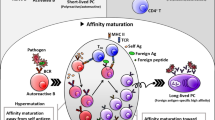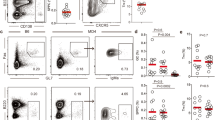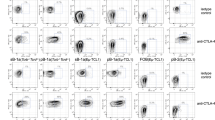Abstract
Over a decade has now passed since the concept of B cells with a regulatory function was resurrected—B cells that produce antibodies with a suppressive effect were first reported in the 1960s and suppressor B cells in the 2000s. In the meantime, some aspects of regulatory B (BREG)-cell biology have been elucidated. Not only have scientists begun to unravel the mechanism of how BREG cells suppress immune responses and which cells they target, but their ontogeny and development has also begun to be determined. To date, key roles for BREG cells have been identified in the regulation of several immune-mediated processes, including autoimmunity and responses to infectious disease and cancer. This Review highlights these advances in the study of BREG cells, and outlines what is known about their phenotype as well as their suppressive role in autoimmunity from studies in both mice and humans. A particular emphasis is placed on BREG-cell function in rheumatic diseases.
Key Points
-
Regulatory B (BREG) cells potently suppress type I T-helper (TH1)-cell differentiation, inhibit autoimmune pathogenesis, restore immune homeostasis and repress antitumor immune responses (to promote cancer growth)
-
BREG cells suppress TH1-cell differentiation by the provision of interleukin (IL)-10 and via cell–cell contact
-
No definitive phenotype has been identified for BREG cells
-
Human BREG cells share several similarities with their rodent counterparts, including an immature phenotype and the capacity to suppress TH1-cell differentiation via the release of IL-10
-
Further studies on the ontogeny, phenotype and suppressive function of BREG cells are needed to understand their biology and function in the pathophysiology of autoimmune diseases, allergy, infection and cancer
-
Given the success in expanding BREG cells in vitro, BREG-cell-based therapy is a promising therapeutic avenue that could be useful in a wide range of immune diseases
This is a preview of subscription content, access via your institution
Access options
Subscribe to this journal
Receive 12 print issues and online access
$209.00 per year
only $17.42 per issue
Buy this article
- Purchase on Springer Link
- Instant access to full article PDF
Prices may be subject to local taxes which are calculated during checkout


Similar content being viewed by others
References
Shimamura, T., Habu, S., Hashimoto, K. & Sasaki, S. Feedback suppression of the immune response in vivo. III. Lyt-1+ B cells are suppressor-inducer cells. Cell. Immunol. 83, 221–224 (1984).
Shimamura, T., Hashimoto, K. & Sasaki, S. Feedback suppression of the immune response in vivo. I. Immune B cells induce antigen-specific suppressor T cells. Cell. Immunol. 68, 104–113 (1982).
Shimamura, T., Hashimoto, K. & Sasaki, S. Feedback suppression of the immune response in vivo. II. Involvement of prostaglandins in the generation of suppressor-inducer B lymphocytes. Cell. Immunol. 69, 192–195 (1982).
Wolf, S. D., Dittel, B. N., Hardardottir, F. & Janeway, C. A. Jr. Experimental autoimmune encephalomyelitis induction in genetically B cell-deficient mice. J. Exp. Med. 184, 2271–2278 (1996).
Fillatreau, S., Sweenie, C. H., McGeachy, M. J., Gray, D. & Anderton, S. M. B cells regulate autoimmunity by provision of IL-10. Nat. Immunol. 3, 944–950 (2002).
Mauri, C., Gray, D., Mushtaq, N. & Londei, M. Prevention of arthritis by interleukin 10-producing B cells. J. Exp. Med. 197, 489–501 (2003).
Mizoguchi, A., Mizoguchi, E., Smith, R. N., Preffer, F. I. & Bhan, A. K. Suppressive role of B cells in chronic colitis of T cell receptor alpha mutant mice. J. Exp. Med. 186, 1749–1756 (1997).
Mizoguchi, A., Mizoguchi, E., Takedatsu, H., Blumberg, R. S. & Bhan, A. K. Chronic intestinal inflammatory condition generates IL-10-producing regulatory B cell subset characterized by CD1d upregulation. Immunity 16, 219–230 (2002).
Mizoguchi, E., Mizoguchi, A., Preffer, F. I. & Bhan, A. K. Regulatory role of mature B cells in a murine model of inflammatory bowel disease. Int. Immunol. 12, 597–605 (2000).
Yanaba, K. et al. A regulatory B cell subset with a unique CD1dhiCD5+ phenotype controls T cell-dependent inflammatory responses. Immunity 28, 639–650 (2008).
Shimomura, Y. et al. Regulatory role of B-1 B cells in chronic colitis. Int. Immunol. 20, 729–737 (2008).
Yanaba, K., Bouaziz, J. D., Matsushita, T., Tsubata, T. & Tedder, T. F. The development and function of regulatory B cells expressing IL-10 (B10 cells) requires antigen receptor diversity and TLR signals. J. Immunol. 182, 7459–7472 (2009).
Garaud, S. et al. IL-10 production by B cells expressing CD5 with the alternative exon 1B. Ann. NY Acad. Sci. 1173, 280–285 (2009).
O'Garra, A. & Howard, M. IL-10 production by CD5 B cells. Ann. NY Acad. Sci. 651, 182–199 (1992).
Evans, J. G. et al. Novel suppressive function of transitional 2 B cells in experimental arthritis. J. Immunol. 178, 7868–7878 (2007).
Gray, M., Miles, K., Salter, D., Gray, D. & Savill, J. Apoptotic cells protect mice from autoimmune inflammation by the induction of regulatory B cells. Proc. Natl Acad. Sci. USA 104, 14080–14085 (2007).
Loder, F. et al. B cell development in the spleen takes place in discrete steps and is determined by the quality of B cell receptor-derived signals. J. Exp. Med. 190, 75–89 (1999).
Srivastava, B., Lindsley, R. C., Nikbakht, N. & Allman, D. Models for peripheral B cell development and homeostasis. Semin. Immunol. 17, 175–182 (2005).
Blair, P. A. et al. Selective targeting of B cells with agonistic anti-CD40 is an efficacious strategy for the generation of induced regulatory T2-like B cells and for the suppression of lupus in MRL/lpr mice. J. Immunol. 182, 3492–3502 (2009).
Barr, T. A., Brown, S., Ryan, G., Zhao, J. & Gray, D. TLR-mediated stimulation of APC: Distinct cytokine responses of B cells and dendritic cells. Eur. J. Immunol. 37, 3040–3053 (2007).
Lenert, P., Brummel, R., Field, E. H. & Ashman, R. F. TLR-9 activation of marginal zone B cells in lupus mice regulates immunity through increased IL-10 production. J. Clin. Immunol. 25, 29–40 (2005).
DiLillo, D. J., Matsushita, T. & Tedder, T. F. B10 cells and regulatory B cells balance immune responses during inflammation, autoimmunity, and cancer. Ann. NY Acad. Sci. 1183, 38–57 (2010).
Rafei, M. et al. A granulocyte–macrophage colony-stimulating factor and interleukin-15 fusokine induces a regulatory B cell population with immune suppressive properties. Nat. Med. 15, 1038–1045 (2009).
Lundy, S. K. & Fox, D. A. Reduced Fas ligand-expressing splenic CD5+ B lymphocytes in severe collagen-induced arthritis. Arthritis Res. Ther. 11, R128 (2009).
Lundy, S. K. Killer B lymphocytes: the evidence and the potential. Inflamm. Res. 58, 345–357 (2009).
Matsushita, T., Yanaba, K., Bouaziz, J. D., Fujimoto, M. & Tedder, T. F. Regulatory B cells inhibit EAE initiation in mice while other B cells promote disease progression. J. Clin. Invest. 118, 3420–3430 (2008).
Lampropoulou, V. et al. TLR-activated B cells suppress T cell-mediated autoimmunity. J. Immunol. 180, 4763–4773 (2008).
Anderton, S. M. & Fillatreau, S. Activated B cells in autoimmune diseases: the case for a regulatory role. Nat. Clin. Pract. Rheumatol. 4, 657–666 (2008).
Hussain, S. & Delovitch, T. L. Intravenous transfusion of BCR-activated B cells protects NOD mice from type 1 diabetes in an IL-10-dependent manner. J. Immunol. 179, 7225–7232 (2007).
Parekh, V. V. et al. B cells activated by lipopolysaccharide, but not by anti-Ig and anti-CD40 antibody, induce anergy in CD8+ T cells: role of TGF-β 1. J. Immunol. 170, 5897–5911 (2003).
Huynh, M. L., Fadok, V. A. & Henson, P. M. Phosphatidylserine-dependent ingestion of apoptotic cells promotes TGF-β1 secretion and the resolution of inflammation. J. Clin. Invest. 109, 41–50 (2002).
Mann, M. K., Maresz, K., Shriver, L. P., Tan, Y. & Dittel, B. N. B cell regulation of CD4+CD25+ T regulatory cells and IL-10 via B7 is essential for recovery from experimental autoimmune encephalomyelitis. J. Immunol. 178, 3447–3456 (2007).
Duddy, M. et al. Distinct effector cytokine profiles of memory and naive human B cell subsets and implication in multiple sclerosis. J. Immunol. 178, 6092–6099 (2007).
Duddy, M. E., Alter, A. & Bar-Or, A. Distinct profiles of human B cell effector cytokines: a role in immune regulation? J. Immunol. 172, 3422–3427 (2004).
Gantner, F. et al. CD40-dependent and -independent activation of human tonsil B cells by CpG oligodeoxynucleotides. Eur. J. Immunol. 33, 1576–1585 (2003).
Wagner, M. et al. IL-12p70-dependent TH1 induction by human B cells requires combined activation with CD40 ligand and CpG DNA. J. Immunol. 172, 954–963 (2004).
Tu, W. et al. Efficient generation of human alloantigen-specific CD4+ regulatory T cells from naive precursors by CD40-activated B cells. Blood 112, 2554–2562 (2008).
Zheng, J., Liu, Y., Lau, Y. L. & Tu, W. CD40-activated B cells are more potent than immature dendritic cells to induce and expand CD4+ regulatory T cells. Cell. Mol. Immunol. 7, 44–50 (2010).
Blair, P. A. et al. CD19+CD24hiCD38hi B cells exhibit regulatory capacity in healthy individuals but are functionally impaired in systemic lupus erythematosus patients. Immunity 32, 129–140 (2010).
Correale, J., Farez, M. & Razzitte, G. Helminth infections associated with multiple sclerosis induce regulatory B cells. Ann. Neurol. 64, 187–199 (2008).
Tretter, T. et al. Induction of CD4+ T-cell anergy and apoptosis by activated human B cells. Blood 112, 4555–4564 (2008).
Chun, H. Y. et al. Cytokine IL-6 and IL-10 as biomarkers in systemic lupus erythematosus. J. Clin. Immunol. 27, 461–466 (2007).
Gateva, V. et al. A large-scale replication study identifies TNIP1, PRDM1, JAZF1, UHRF1BP1 and IL10 as risk loci for systemic lupus erythematosus. Nat. Genet. 41, 1228–1233 (2009).
Anolik, J. H. et al. Delayed memory B cell recovery in peripheral blood and lymphoid tissue in systemic lupus erythematosus after B cell depletion therapy. Arthritis Rheum. 56, 3044–3056 (2007).
Palanichamy, A. et al. Novel human transitional B cell populations revealed by B cell depletion therapy. J. Immunol. 182, 5982–5993 (2009).
Sanz, I. Connective tissue diseases: The conundrum of B cell depletion in SLE. Nat. Rev. Rheumatol. 5, 304–305 (2009).
Cuss, A. K. et al. Expansion of functionally immature transitional B cells is associated with human-immunodeficient states characterized by impaired humoral immunity. J. Immunol. 176, 1506–1516 (2006).
De Milito, A., Morch, C., Sonnerborg, A. & Chiodi, F. Loss of memory (CD27) B lymphocytes in HIV-1 infection. AIDS 15, 957–964 (2001).
Ho, J. et al. Two overrepresented B cell populations in HIV-infected individuals undergo apoptosis by different mechanisms. Proc. Natl Acad. Sci. USA 103, 19436–19441 (2006).
Malaspina, A. et al. Appearance of immature/transitional B cells in HIV-infected individuals with advanced disease: correlation with increased IL-7. Proc. Natl Acad. Sci. USA 103, 2262–2267 (2006).
Martinez-Maza, O., Crabb, E., Mitsuyasu, R., Fahey, J. & Giorgi, J. Infection with the human immunodeficiency virus (HIV) is associated with an in vivo increase in B lymphocyte activation and immaturity. J. Immunol. 138, 3720–3724 (1987).
Plebani, A. et al. A novel immunodeficiency characterized by the exclusive presence of transitional B cells unresponsive to CpG. Immunology 121, 183–188 (2007).
Ehrenstein, M. R. et al. Compromised function of regulatory T cells in rheumatoid arthritis and reversal by anti-TNFα therapy. J. Exp. Med. 200, 277–285 (2004).
Valencia, X., Yarboro, C., Illei, G. & Lipsky, P. E. Deficient CD4+CD25high T regulatory cell function in patients with active systemic lupus erythematosus. J. Immunol. 178, 2579–2588 (2007).
Wing, K. & Sakaguchi, S. Regulatory T cells exert checks and balances on self tolerance and autoimmunity. Nat. Immunol. 11, 7–13 (2010).
Sugimoto, K. et al. Inducible IL-12-producing B cells regulate TH2-mediated intestinal inflammation. Gastroenterology 133, 124–136 (2007).
Wei, B. et al. Integration of B cells and CD8+ T in the protective regulation of systemic epithelial inflammation. Clin. Immunol. 127, 303–312 (2008).
Wei, B. et al. Mesenteric B cells centrally inhibit CD4+ T cell colitis through interaction with regulatory T cell subsets. Proc. Natl Acad. Sci. USA 102, 2010–2015 (2005).
Watanabe, R. et al. Regulatory B cells (B10 cells) have a suppressive role in murine lupus: CD19 and B10 cell deficiency exacerbates systemic autoimmunity. J. Immunol. 184, 4801–4809 (2010).
Yanaba, K. et al. B-lymphocyte contributions to human autoimmune disease. Immunol. Rev. 223, 284–299 (2008).
Tian, J. et al. Lipopolysaccharide-activated B cells down-regulate TH1 immunity and prevent autoimmune diabetes in nonobese diabetic mice. J. Immunol. 167, 1081–1089 (2001).
Acknowledgements
C. Mauri's work is funded by grant MP/17707 from Arthritis Research UK (formerly the Arthritis Research Campaign) Program. P. A. Blair has been supported by the Oliver Bird Rheumatism Program and by grant P7575 from Lupus UK. He is currently funded by grant R080521 from Guy's and St Thomas Trust (awarded to G. Lombardi, Medical Research Council Centre for Transplantation, Kings College London).
Author information
Authors and Affiliations
Contributions
C. Mauri and P. A. Blair contributed equally to all aspects of this manuscript.
Corresponding author
Ethics declarations
Competing interests
The authors declare no competing financial interests.
Rights and permissions
About this article
Cite this article
Mauri, C., Blair, P. Regulatory B cells in autoimmunity: developments and controversies. Nat Rev Rheumatol 6, 636–643 (2010). https://doi.org/10.1038/nrrheum.2010.140
Published:
Issue Date:
DOI: https://doi.org/10.1038/nrrheum.2010.140
This article is cited by
-
Immune-checkpoint expression in antigen-presenting cells (APCs) of cytomegaloviruses infection after transplantation: as a diagnostic biomarker
Archives of Microbiology (2023)
-
The Role of Epigenetics in the Chronic Sinusitis with Nasal Polyp
Current Allergy and Asthma Reports (2021)
-
Effects of rituximab therapy on B cell differentiation and depletion
Clinical Rheumatology (2020)
-
Post-transcriptional regulator Rbm47 elevates IL-10 production and promotes the immunosuppression of B cells
Cellular & Molecular Immunology (2019)
-
T follicular regulatory cells suppress Tfh-mediated B cell help and synergistically increase IL-10-producing B cells in breast carcinoma
Immunologic Research (2019)



